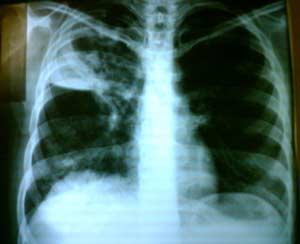Cavitary tuberculosis is a chronic pulmonary form characterized by cavitary lesions surrounded by extensive fibrous tissue. This is also the final stage of primary tuberculosis forms and has the highest potential for transmission due to its presence in the sputum of infected individuals.
 |
X-ray image of a patient with pulmonary tuberculosis |
The primary pulmonary forms that lead to cavitary tuberculosis include infiltrative tuberculosis with cavities, caseous pneumonia, cavitary pulmonary tuberculosis, disseminated hematogenous tuberculosis with cavities, and nodular tuberculosis with cavities. The transition of these pulmonary forms to cavitary tuberculosis is attributed to the weakened immune response against tuberculosis in patients, often due to late diagnosis and improper treatment methods, insufficient drug combinations, or not adhering to the treatment duration of 6-8 months.
In adults and the elderly suffering from pulmonary tuberculosis, cavitary tuberculosis is the most common form, accounting for nearly 80%. The majority of these cases are diagnosed late, often after 12 months, due to limited diagnostic capabilities at healthcare facilities.
To address this issue, recently, Hospital 103 has made significant advancements in disease diagnosis, leading to more effective treatment. Experience has shown that the initial diagnosis is based on the history of patients with tuberculosis lasting from 6 months to over a year, who often present with severe tuberculosis symptoms such as cough, high fever or low-grade fever in the evening, hemoptysis, dyspnea, weight loss, night sweats, poor appetite and sleep, fatigue, and intermittent tuberculosis intoxication alongside stable phases. Lung examinations reveal moist crackles, coarse crackles, localized wheezing, diminished breath sounds, a sunken chest, and dull percussion notes. The extent of damage is significant in both lungs. Standard frontal and lateral chest X-rays reveal multiple cavities, which may be round or irregular, ranging in size from small to large, with large cavities constituting over 50%. Some patients have gigantic cavities, exceeding 6 cm, mainly located in the upper lobes of one or both lungs. In some cases, X-rays also show significant fibrotic changes surrounding the cavities, with pleural fibrosis causing tracheal, mediastinal, bronchial, and cardiac constriction, leading to narrowed intercostal spaces. To accurately determine the number of cavities, cavity walls, cavity shapes, and locations, all patients undergo chest CT scans and flexible bronchoscopy. With precise diagnostic results, the hospital establishes specific treatment protocols for each case.
The treatment goal for cavitary tuberculosis is to stabilize the lesions, resolve tuberculosis intoxication, and achieve negative sputum cultures for Mycobacterium tuberculosis. Based on experience, prior to treatment, patients are clinically evaluated by doctors who conduct sensitivity testing to determine which anti-tuberculosis drugs may be resistant. Simultaneously, patients receive a combination of at least 2-4 drugs to which the tuberculosis bacilli remain sensitive.
To ensure effective and safe medication usage, all patients undergo tests for liver enzymes, blood uric acid, blood urea, creatinine, urine, and ear-eye examinations. The medications used at Hospital 103 for treating cavitary tuberculosis include rifampicin, pyrazinamide, ethambutol, along with second-line anti-tuberculosis drugs such as ciprofloxacin 500 mg tablets, intramuscular kanamycin, ethionamide tablets, and cycloserine.
For patients who had drug-resistant tuberculosis prior to admission, treatment must be extended, lasting approximately 12-18 months after achieving negative sputum cultures for Mycobacterium tuberculosis. For those patients who do not achieve negative cultures after 6 months of treatment or those with tuberculosis lesions in one lung but relatively good health and lung function, surgical resection of lung lobes or whole lung may be indicated. Thanks to the proactive diagnostic and treatment experience at Hospital 103, many patients with cavitary tuberculosis have shown significant improvement and rapid recovery.
Professor – Doctor Bui Xuan Tam


















































